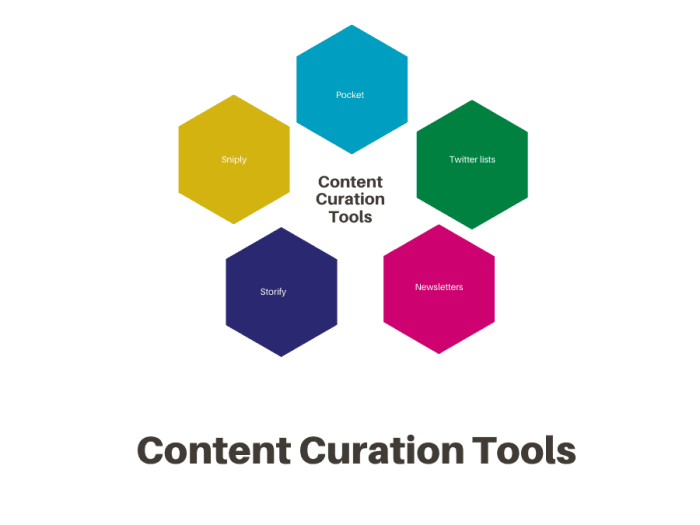Diving into the world of Content Curation Tools, get ready to level up your digital marketing strategy with the latest and greatest tools at your disposal. From social media to news curation, we’ve got you covered with all the must-know info.
Definition of Content Curation Tools
Content curation tools are software or platforms that help users discover, gather, organize, and share relevant content from various online sources. These tools differ from content creation tools in that they focus on finding and compiling existing content rather than generating new content from scratch.
Examples of Popular Content Curation Tools
- 1. Pocket: A tool that allows users to save articles, videos, and other online content to read or share later.
- 2. Feedly: An RSS feed reader that aggregates content from different websites into one interface for easy consumption.
- 3. Curata: A content curation platform that helps marketers find, organize, and share content to engage their audience.
The Importance of Using Content Curation Tools in a Digital Marketing Strategy
Content curation tools play a crucial role in digital marketing by helping marketers discover relevant content to share with their audience, saving time and effort in content creation. By curating high-quality content from trusted sources, marketers can establish themselves as industry experts and build credibility with their audience. Additionally, content curation tools enable marketers to stay up-to-date with industry trends and provide valuable resources to their followers, ultimately driving engagement and loyalty.
Types of Content Curation Tools

Content curation tools come in various forms, each catering to different needs and preferences. Let’s explore the different categories and features of these tools to understand their benefits and drawbacks.
Social Media Curation
Social media curation tools are designed to help users discover, organize, and share content from various social media platforms. These tools often allow users to schedule posts, monitor engagement, and track trends across multiple channels. Popular examples include Hootsuite, Buffer, and Sprout Social.
News Curation
News curation tools focus on aggregating and curating news articles from different sources to provide users with a comprehensive overview of current events. These tools often feature customizable news feeds, real-time updates, and personalized recommendations based on user preferences. Examples include Flipboard, Feedly, and Google News.
Visual Curation
Visual curation tools are centered around organizing and showcasing visual content such as images, videos, and infographics. These tools often offer features like drag-and-drop interfaces, image editing capabilities, and collaboration options for teams. Pinterest, Canva, and Adobe Spark are popular choices in this category.
Automated vs. Manual Content Curation Tools
Automated content curation tools rely on algorithms to gather and organize content based on predefined criteria or user preferences. These tools can save time and effort by automatically curating relevant content, but they may lack the human touch and personalization that manual curation offers. Manual content curation tools, on the other hand, involve human input in selecting, organizing, and presenting content. While manual curation allows for more nuanced decision-making and customization, it can be time-consuming and labor-intensive.
Benefits and Drawbacks
Automated content curation tools are efficient in quickly generating curated content, saving time and streamlining the curation process. However, they may lack the context and personal touch that manual curation provides, potentially leading to less engaging content. Manual curation tools, on the other hand, allow for greater control over the content selection and presentation, enabling users to tailor curated content to specific audiences. However, manual curation can be resource-intensive and may require more time and effort to maintain quality and relevance.
Best Practices for Content Curation

When it comes to content curation, there are several best practices to keep in mind to ensure that you are effectively sharing valuable information with your audience. Here are some tips on how to curate content using tools, maintain a balance between curated and original content, and the importance of proper attribution and crediting sources.
Tips for Effective Content Curation
- Define your content goals and target audience to curate relevant content.
- Use reliable content curation tools to streamline the process and save time.
- Curate a mix of content types such as articles, videos, infographics, and podcasts to keep your audience engaged.
- Add your unique perspective or commentary to curated content to provide added value.
- Regularly update and refresh your curated content to ensure its relevance and accuracy.
Maintaining a Balance Between Curated and Original Content, Content Curation Tools
- Strive for a healthy mix of curated and original content to showcase your expertise while providing diverse perspectives.
- Create a content calendar to schedule curated and original content strategically.
- Engage with your audience to understand their preferences and tailor your content mix accordingly.
- Monitor the performance of both curated and original content to optimize your content strategy.
Importance of Proper Attribution and Crediting Sources
- Always credit the original source when curating content to respect intellectual property rights.
- Provide proper attribution through links, citations, or mentions to acknowledge the creators of curated content.
- Build credibility and trust with your audience by transparently attributing sources and giving credit where it’s due.
- Avoid plagiarism by properly citing sources and obtaining permission when necessary.
Integrating Content Curation Tools with Marketing Strategy
When it comes to integrating content curation tools into a marketing strategy, businesses can leverage these tools to discover, organize, and share relevant content with their target audience. By curating valuable content from various sources, companies can establish themselves as thought leaders in their industry and engage their audience effectively.
Successful Content Curation Strategies
Implementing successful content curation strategies involves selecting high-quality content, adding value through insights or commentary, and sharing it strategically across different platforms. Here are some examples of businesses that have excelled in content curation:
- Buffer: The social media management platform curates industry-related articles and shares them with their audience, positioning themselves as a go-to source for social media trends.
- Hootsuite: This social media management tool curates content about digital marketing and social media, providing valuable resources to their followers and establishing credibility in the industry.
Building Brand Authority and Credibility
Content curation tools play a crucial role in building brand authority and credibility by helping businesses showcase their expertise, stay informed about industry trends, and engage with their audience consistently. By curating relevant and valuable content, companies can establish themselves as trustworthy sources of information and build a loyal following.





